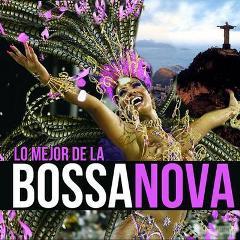Lo Mejor de la Bossa Nova (2011)
Lo Mejor de la Bossa Nova (2011)

01. Garota de Ipanema - Astryd Gukberto 02. Eu Sei Que Vou Te Amar - María Creuza, Toquinho, Vinicius de Moraes 03. Mais Que Nada - Orquesta Oliveiro Valdes 04. Mama Eu Quero - Astrud Gilberto 05. Ela E Carioca - Joao Gilberto 06. Negro, Negro - Edu Lobo 07. Essa Moça Ta Diferente - Flavio Faria 08. Roda - Gilberto Gil 09. Tirls Upstair - A.Carlos Jobim 10. Marcha Cordaz - Escola De Samba 11. Meu Piau - Astrud Gilberto 12. Por Amor - Rilo 13. Procissao - Gilberto Gil 14. Samba do Aviao - A.Carlos Jobim 15. Samba do Veloso - Baden Powell 16. Samba em Paz - Caetano Veloso 17. Samba Rap - Escola Do Samba 18. Berimbau - Baden Powell 19. A Vida Tem Sempre Razao - Carlos Jobim, Miucha 20. Tarde em Itapoâ - Joyce, María Bethania
Created in Brazil in the late 1950s during a period of political change and economical growth, bossa nova has been often described as the music of the Brazilian middle and upper classes. This music style originated in the wealthy neighborhoods that sprouted along the beaches of the city of Rio de Janeiro and both its music and lyrics were composed by middle and upper-class musicians and marketed to the same economic group. For this reason, bossa nova was criticized by some for emphasizing a carefree way of living that little resembled the life of most Brazilians, the great majority of which belonged to the working class.
Indeed, bossa nova compositions often spoke of love, the beach, and beautiful women and seemed to be a depiction of the author's bohemian life rather than a tale of Brazilians' daily struggles as usually happened with samba, a music genre popular among the working class. "The Girl from Ipanema," which became popular outside of Brazil both in its original Portuguese form and in translation, is a perfect example of the uncommitted quality of bossa nova songs. "The Girl from Ipanema" is nothing more than the composer's description of a woman walking down towards the beach, the sweet way in which she moves and how beautiful she is, culminating with the author's statement that she's the most beautiful thing he's ever seen go by. The music that accompanied the first wave of bossa nova lyrics, while unique, used the same altered chords found in jazz music combined with the drum beat characteristic of samba.
Perhaps ironically, bossa nova, the music style associated with complacence, is also considered responsible for the birth of the protest music of the 1960s that denounced the political uproar Brazil found itself in that led to the military coup of 1964. Critical of the insipid character of bossa nova lyrics and influenced by the precarious political and economic situation of Brazil, artists started using music to voice their opinions and as a vehicle to teach the largely uneducated Brazilian population about their country's current social, political and economic status. --- essortment.com
download (mp3 @320 kbs):
uploaded yandex 4shared mega mediafire zalivalka cloudmailru oboom uplea
Last Updated (Wednesday, 05 August 2015 12:50)








